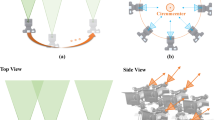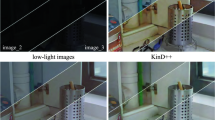Abstract
Complex object illumination transfer is a special challenge in computer vision. In our paper, we put forward a method for complex object illumination transfer. Firstly, the input object image was divided into object components by semantic analysis, to find the reference object images consistent with the object component material in the physical world by material analysis. Material has a great influence on the illumination transfer of object image, so the use of material analysis can greatly reduce the influence of material on the illumination transfer in the later stage. Next, a block matching algorithm was used to deform each reference object image and made it match with each component shape of the input object image. Then, each component of the input object image and each warped reference object image were illuminated by local and global transfer model. Finally, semantic analysis was used to synthesize the re-illumination components of the input object image to obtain the re-illumination input object image. The experimental results prove that the method could make a good effect on the illumination transfer. Our main contribution is the use of semantic and material analysis to split complex objects into simple objects, and skillfully combine semantic and material parsing and composition, block matching algorithm, local and global light migration model to achieve the relighting of complex objects.











Similar content being viewed by others
References
Barnes C, Shechtman E, Goldman DB, Finkelstein A (2010) The generalized patchmatch correspondence algorithm. In: Computer vision - ECCV 2010 11th European Conference on Computer Vision, Heraklion, Crete, Greece, September 5-11, 2010, Proceedings, Part III, pp 29–43
Chabert C-F, Einarsson P, Jones A, Lamond B, Ma W-C, Sylwan S, Hawkins T, Debevec PE (2006) Relighting human locomotion with flowed reflectance fields. In: Finnegan JW, Pfister H (eds) International conference on computer graphics and interactive techniques, SIGGRAPH 2006, Boston, Massachusetts, USA, July 30 - August 3, 2006, Sketches, vol 33. ACM, p 76
Chen X, Wang K, Jin X (2011) Single image based illumination estimation for lighting virtual object in real scene. In: 12th International conference on computer-aided design and computer graphics, CAD/Graphics 2011, Jinan, China, September 15-17, 2011, pp 450–455
Chen X, Jin X, Zhao Q, Wu H (2012) Artistic illumination transfer for portraits. Comput Graph Forum 31(4):1425–1434
Chen X, Jin X, Wang K (2014) Lighting virtual objects in a single image via coarse scene understanding. Sci Chin Inform Sci 57(9):1–14
Chen X, X Jin H W u, Zhao Q (2015) Learning templates for artistic portrait lighting analysis. IEEE Trans Image Process 24(2):608–618
Geusebroek J -M, Burghouts GJ, Smeulders AWM (2005) The amsterdam library of object images. Int J Comput Vis 61(1):103–112
Jin X, Zhao M, Chen X, Zhao Q, Zhu S -C (2010) Learning artistic lighting template from portrait photographs. In: Computer Vision - ECCV 2010, 11th European conference on computer vision, Heraklion, Crete, Greece, September 5-11, 2010, Proceedings, Part IV, pp 101–114
Jin X, Tian Y, Liu N, Ye C, Chi J, Li X, Zhao G (2016) Object image relighting through patch match warping and color transfer, 235–241, 09
Jin X, Li Y, Liu N, Li X, Jiang X, Tian Y, Ge S (2017) Scene relighting using a single reference image through material constrained layer decomposition. In: International symposium on artificial intelligence and robotics, Kitakyushu, Japan, 25-26 November, ISAIR 2017. Springer, pp 37–44
Jin X, Li Y, Liu N, Li X, Jiang X, Xiao C, Ge S (2019) Single reference image based scene relighting via material guided filtering. Opt Laser Technol 110:7–12. Special Issue: Optical Imaging for Extreme Environment
Li X, Han R, Ning N, Zhang X, Jin X (2019) Complex objectillumination transfer through semantic and material parsing and composition. In: The 3rd EAI international conference on robotic sensor networks (ROSENET), Kitakyushu, Japan, 17 August
Lu H, Li Y, Min C, Kim H, Serikawa S (2017) Brain intelligence: go beyond artificial intelligence. Mob Netw Appl 23(7553):368–375
Lu H, Li Y, Mu S, Wang D, Kim H, Serikawa S (2018) Motor anomaly detection for unmanned aerial vehicles using reinforcement learning. IEEE Internet Things J 5(4):2315–2322
Lu H, Li Y, Uemura T, Kim H, Serikawa S (2018) Low illumination underwater light field images reconstruction using deep convolutional neural networks. Futur Gener Comput Syst, 82
Lu H, Wang D, Li Y, Li J, Humar I (2019) Conet: a cognitive ocean network
Quan Z, Zheng B, Zhu W, Latecki LJ (2016) Multi-scale context for scene labeling via flexible segmentation graph. Pattern Recogn 59(C):S0031320316300085
Quan Z, Cheng Z, Yu W, Fan Y, Hu Z, Wu X, Ou W, Zhu W, Latecki LJ (2017) Face recognition via fast dense correspondence. Multimed Tools Appl 12:1–19
Quan Z, Yang W, Gao G, Ou W, Lu H, Jie hen, Latecki LJ (2018) Multi-scale deep context convolutional neural networks for semantic segmentation. World Wide Web-internet and Web Information Systems 22(7):1–16
Ren P, Dong Y, Lin S, Tong X, Guo B (2015) Image based relighting using neural networks. ACM Trans Graph 34(4):111,1–111,12
Serikawa S, Lu H (2014) Underwater image dehazing using joint trilateral filter. Comput Electr Eng 40(1):41–50
Shih Y -C, Paris S, Durand F, Freeman WT (2013) Data-driven hallucination of different times of day from a single outdoor photo. ACM Trans Graph 32(6):200:1–200:11
Xu Z, Sunkavalli K, Hadap S, Ramamoorthi R (2018) Deep image-based relighting from optimal sparse samples. ACM Trans Graph 37(4):126:1–126:13
Yu H, He F, Pan Y (2019) A novel segmentation model for medical images with intensity inhomogeneity based on adaptive perturbation. Multimedia Tools Appl 78(9):11779–11798
Yu H, He F, Pan Y (2020) A scalable region-based level set method using adaptive bilateral filter for noisy image segmentation. Multimed Tools Appl 79 (9–10):5743–5765
Zhang J, He F, Chen Y (2020) A new haze removal approach for sky/river alike scenes based on external and internal clues. Multimed Tools Appl 79(3–4):2085–2107
Zhang S, He F, Ren W, Yao J (2020) Joint learning of image detail and transmission map for single image dehazing. Vis Comput 36(2):305–316
Zhou Q, Cheng J, Lu H, Fan Y, Zhang S, Wu X, Zheng B, Ou W, Latecki LJ (2018) Learning adaptive contrast combinations for visual saliency detection. Multimed Tools Appl 1–29:11
Acknowledgements
Parts of the results and figures presented in this paper have previously appeared in our previous work [12]. We add more technical details and experimental results in this version. This work is partially supported by the National Natural Science Foundation of China (grant numbers 61701008, 61772047), the Open Project Program of State Key Laboratory of Cryptology (grant number MMKFKT201804), the Beijing Natural Science Foundation (grant number 19L2040), the Open Project Program of State Key Laboratory of Virtual Reality Technology and Systems, Beihang University (grant number VRLAB2019C03) and the Fundamental Research Funds for the Central Universities (grant number 328201907).
Author information
Authors and Affiliations
Corresponding author
Additional information
Publisher’s note
Springer Nature remains neutral with regard to jurisdictional claims in published maps and institutional affiliations.
Rights and permissions
About this article
Cite this article
Jin, X., Ning, N., Han, R. et al. Complex object relighting via split-then-composition by semantics and materials. Multimed Tools Appl 79, 24185–24197 (2020). https://doi.org/10.1007/s11042-020-09071-6
Received:
Revised:
Accepted:
Published:
Issue Date:
DOI: https://doi.org/10.1007/s11042-020-09071-6




